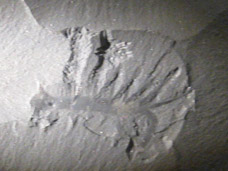
Hallucigenia is a genus of Cambrian animal resembling worms, known from articulated fossils in Burgess Shale-type deposits in Canada and China, and from isolated spines around the world. The generic name reflects the type species' unusual appearance and eccentric history of study; when it was erected as a genus, H. sparsa was reconstructed as an enigmatic animal upside down and back to front. Hallucigenia is later recognized as part of lobopodians, a grade of Paleozoic panarthropods where the velvet worms, water bears, and arthropods arose.
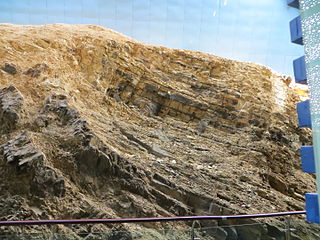
The Maotianshan Shales are a series of Early Cambrian deposits in the Chiungchussu Formation, famous for their Konservat Lagerstätten, deposits known for the exceptional preservation of fossilized organisms or traces. The Maotianshan Shales form one of some forty Cambrian fossil locations worldwide exhibiting exquisite preservation of rarely preserved, non-mineralized soft tissue, comparable to the fossils of the Burgess Shale. They take their name from Maotianshan Hill in Chengjiang County, Yunnan Province, China.
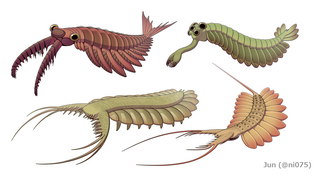
Dinocaridida is a proposed fossil taxon of basal arthropods that flourished in the Cambrian period with occasional Ordovician and Devonian records. Characterized by a pair of frontal appendages and series of body flaps, the name of Dinocaridids comes from Greek, "deinos" and "caris", referring to the suggested role of some of these members as the largest marine predators of their time. Dinocaridids are occasionally referred to as the 'AOPK group' by some literatures, as the group compose of Radiodonta, Opabinia, Pambdelurion and Kerygmachela. It is most likely paraphyletic, with Kerygmachela and Pambdelurion more basal than the clade compose of Opabinia, Radiodonta and other arthropods.

Cheloniellida is a taxon of extinct Paleozoic arthropods. As of 2018, 7 monotypic genera of cheloniellids had been formally described, whose fossils are found in marine strata ranging from Ordovician to Devonian in age. Cheloniellida has a controversial phylogenetic position, with previous studies associated it as either a member or relative of various fossil and extant arthropod taxa. It was later accepted as a member of Vicissicaudata within Artiopoda.

Parapeytoia was a prehistoric animal that lived over 530 million years ago in the Maotianshan shales of prehistoric China. It was interpreted as an anomalocaridid (radiodont) with legs, but later studies reveal it was a megacheiran, a group of arthropods which are no longer thought to be closely related to the radiodonts.

Acanthomeridion is an extinct arthropod found in the Chengjiang fauna deposits of China. In 1997, it was placed in its own, monotypic family, Acanthomeridiidae. It is known from eight specimens, all found in China.

Megacheira is an extinct class of predatory arthropods that possessed a pair of great appendages, hence the class name as well as the common name "great appendage arthropods". Their neural structures and deutocerebral appendages resemble those of chelicerates. Most of them were found in marine environments throughout the world from the lower to middle Cambrian. Megacheirans were important components of several faunas, including the Burgess, Wheeler and Maotianshan Shales Lagerstatten.
Clypecaris is genus of bivalved Cambrian arthropod known from the Chengjiang biota. The genus was initially described for the type species C. pteroidea by Hou, 1999. A second species C. serrata was described by Yang et al. in 2016.
Ercaicunia is genus of Cambrian arthropod known for being a member of the Chengjiang biota, containing the single species E. multinodosa. It was described by Luo et al. in 1999. Specimens were CT scanned in 2019, which revealed it to be a stem-group crustacean.
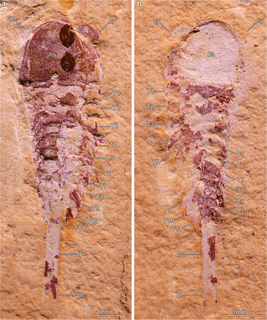
Jianshania is genus of Cambrian arthropod known from the Chengjiang biota, containing the single species J. furfactus. It was described by Luo et al. in 1999. In 2020, a specimen originally assigned to the species was found to represent the separate fuxianhuiid taxon Xiaocaris pending revision of the type specimen.
Pygmaclypeatus is a genus of trilobite-like artiopodan arthropod from the Cambrian aged Chengjiang biota of southern China. It is considered to be closely related to Retifacies.

Radiodonta is an extinct order of stem-group arthropods that was successful worldwide during the Cambrian period. They may be referred to as radiodonts, radiodontans, radiodontids, anomalocarids, or anomalocaridids, although the latter originally refer to the family Anomalocarididae, which previously included all species of this order but is now restricted to only a few species. Radiodonts are distinguished by their distinctive frontal appendages, which are morphologically diverse and used for a variety of functions. Radiodonts included the earliest large predators known, but they also included sediment sifters and filter feeders. Some of the most famous species of radiodonts are the Cambrian taxa Anomalocaris canadensis, Hurdia victoria, Peytoia nathorsti, and Amplectobelua symbrachiata, the Ordovician Aegirocassis benmoulai and the Devonian Schinderhannes bartelsi.

The Luolishaniidae or Luolishaniida are a group of Cambrian lobopodians with anterior 5 or 6 pairs of setiferous lobopods. Most luolishaniids also have posterior lobopods each with a hooked claws, and thorn-shaped sclerites arranged as three or more per trunk segment. The type genus is based on Luolishania longicruris Hou and Chen, 1989, from the Chengjiang Lagerstatte, South China. They are presumed to have been benthic suspension or filter feeders.

Chengjiangocaris is an extinct genus of fuxianhuiid arthropod known from the Cambrian of South China. It contains two species, C. longiformis which was described in 1991. C. kunmingensis was described in 2013 by Javier Ortega-Hernández and colleagues. One specimen of C. kunmingensis shows detailed evidence of a nervous system.

The Artiopoda is a grouping of extinct arthropods that includes trilobites and their close relatives. It was erected by Hou and Bergström in 1997 to encompass a wide diversity of arthropods that would traditionally have been assigned to the Trilobitomorpha. Hou and Bergström used the name Lamellipedia as a superclass to replace Trilobitomorpha that was originally erected at the subphylum level, which they considered inappropriate.

Sinoburius is an extinct genus of xandarellid artiopodan known from the Cambrian aged Chengjiang Biota of China. It is only known from the type species S. lunaris, which was described in 1991. It is a rare fossil within the Chengjiang assemblage. Like other Xandarellids, Sinoburius has an unmineralised exoskeleton. Adult individuals are around 7-8 millimetres in length, with stalked eyes present on the ventral side.
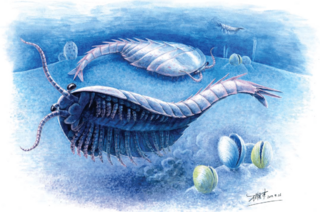
Fuxianhuiida is an extinct clade of arthropods from the Cambrian of China. All currently known species are from Cambrian Series 2 aged deposits in Yunnan Province, including the Chenjiang biota. They are generally considered to be close to the base of Euarthropoda, but have also been considered to be early mandibulates. They reach a size of up to 15 cm, and are interpreted as benthic predators and scavengers. The fuxianhuiid exoskeleton is unmineralised, and the number of tergites ranges from 15 to over 40. The cephalon is covered by a head shield and contains stalked eyes connected by the anterior sclerite, antennae, a butterfly shaped hyposome and a posterior facing mouth. Fuxianhuiids possess specialized post-antennal appendages with serrated edges used for food processing. The presence of gnathobases in members of Chengjiangocardidae suggests that they were capable of durophagy. In most fuxianhuiids, the thorax tergites narrow posteriorly, terminating in either a swimming paddle or paired flukes with a tailspine. In members of Fuxianhuiidae the thorax is divided into two sections, the anterior wide opisthothorax and the posterior narrow limbless tail-like abdomen. Many specimens are known with exceptional soft tissue preservation, including preserved guts and neural tissue, which given their basal phylogenetic position makes them important in understanding the evolution of arthropoda as a whole.
Luolishania is an extinct genus of lobopodian worm and known from the Lower Cambrian Chiungchussu Formation of the Chengjiang County, Yunnan Province, China. A monotypic genus, it contains one species Luolishania longicruris. It was discovered and described by Hou Xian-Guang and Chen Jun-Yuan in 1989. It is one of the superarmoured Cambrian lobopodians suspected to be either an intermediate form in the origin of velvet worms (Onychophora) or basal to at least Tardigrada and Arthropoda. It is the basis of the family name Luolishaniidae, which also include other related lobopods such as Acinocricus, Collinsium, Facivermis, and Ovatiovermis. Along with Microdictyon, it is the first lobopodian fossil discovered from China.

Hallucigeniidae is a family of extinct worms belonging to the group Lobopodia that originated during the Cambrian explosion. It is based on the species Hallucigenia sparsa, the fossil of which was discovered by Charles Doolittle Walcott in 1911 from the Burgess Shale of British Columbia. The name Hallucigenia was created by Simon Conway Morris in 1977, from which the family was erected after discoveries of other hallucigeniid worms from other parts of the world. Classification of these lobopods and their retatives are still controversial, and the family consists of at least four genera.

Lenisambulatrix is a genus of extinct worm belonging to the group Lobopodia and known from the Lower Cambrian Maotianshan shale of China. It is represented by a single species L. humboldti. The incomplete fossil was discovered and described by Qiang Ou and Georg Mayer in 2018. Due to its missing parts, its relationship with other lobopodians is not clear. It shares many structural features with another Cambrian lobopodian Diania cactiformis, a fossil of which was found alongside it.

















